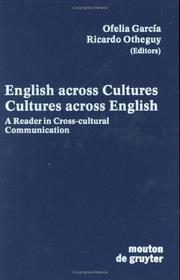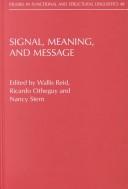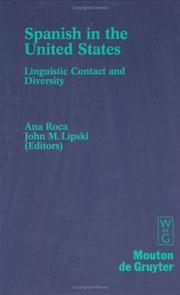| Listing 1 - 9 of 9 |
Sort by
|

ISBN: 3110118114 0899255132 311178200X 3110848325 Year: 1989 Volume: 53 Publisher: Berlin Mouton de Gruyter
Abstract | Keywords | Export | Availability | Bookmark
 Loading...
Loading...Choose an application
- Reference Manager
- EndNote
- RefWorks (Direct export to RefWorks)
Sociolinguistics --- English language --- Dialectology --- Communication interculturelle --- Communication interethnique --- Communications interculturelles --- Dialogue interculturel --- Intercultural communication --- Interculturalité --- Interculturele communicatie --- Variation --- Social aspects --- Foreign countries --- Study and teaching --- Foreign speakers --- Intercultural communication. --- Variation. --- Social aspects. --- Foreign speakers. --- Cross-cultural communication --- Communication --- Culture --- Cross-cultural orientation --- Cultural competence --- Multilingual communication --- Technical assistance --- EFL (Language study) --- English as a foreign language --- English as a second language --- English to speakers of other languages --- ESL (Language study) --- ESOL (Language study) --- Teaching English as a second language --- TEFL (Language study) --- TESL (Language study) --- English language in foreign countries --- World Englishes --- Anthropological aspects --- Foreign students --- Dialects --- Germanic languages --- ENGLISH LANGUAGE --- INTERCULTURAL COMMUNICATION --- VARIETIES --- SOCIAL ASPECTS
Book
ISBN: 9780199737406 9780199737390 0199737401 0199737398 0199876258 9786613423320 1283423324 0199918627 Year: 2012 Publisher: Oxford Oxford University Press
Abstract | Keywords | Export | Availability | Bookmark
 Loading...
Loading...Choose an application
- Reference Manager
- EndNote
- RefWorks (Direct export to RefWorks)
"Spanish in New York" is a groundbreaking sociolinguistic analysis of immigrant bilingualism in a U.S. setting. Drawing on one of the largest corpora of spoken Spanish ever assembled for a single city, Otheguy and Zentella demonstrate the extent to which the language of Latinos in New York City represents a continuation of structural variation as it is found in Latin America, as well as the extent to which Spanish has evolved in New York City. Their study, which focuses on language contact, dialectal leveling, and structural continuity, carefully distinguishes between the influence of English and the mutual influences of forms of Spanish with roots in different parts of Latin America. Taking variationist sociolinguistics as its guiding paradigm, the book compares the Spanish of New Yorkers born in Latin America with that of those born in New York City. Findings are grounded in a comparative analysis of 140 sociolinguistic interviews of speakers with origins in Colombia, Cuba, Dominican Republic, Ecuador, Mexico and Puerto Rico. Quantitative analysis (correlations, anovas, variable hierarchies, constraint hierarchies) reveals the effect on the use of subject personal pronouns of the speaker's gender, immigrant generation, years spent in New York, and amount of exposure to English and to varieties of Spanish. In addition to these speaker factors, structural and communicative variables, including the person and tense of the verb and its referential status, have a significant impact on pronominal usage in New York City.
Spanish language --- Bilingualism --- Provincialisms --- Pronoun --- Dialects --- New York State --- Spanisch. --- Pronoun. --- Provincialisms. --- New York (State) --- Staat New York. --- Bilingualism. --- Dialects. --- Dialectology --- Language and languages --- Languages in contact --- Multilingualism --- Castilian language --- Romance languages --- Spanish language - Provincialisms - New York (State) - New York --- Spanish language - Pronoun --- Spanish language - Dialects - New York (State) - New York --- Bilingualism - New York (State) - New York --- New York [state]

ISBN: 902721557X 1588112896 9781588112897 9789027215574 9789027282231 9027282234 1283234114 9781283234115 9786613234117 6613234117 Year: 2002 Volume: 48 Publisher: Amsterdam Benjamins
Abstract | Keywords | Export | Availability | Bookmark
 Loading...
Loading...Choose an application
- Reference Manager
- EndNote
- RefWorks (Direct export to RefWorks)
This is the second volume of papers on sign-based linguistics to emerge from Columbia School linguistics conferences. One set of articles offers semantic analyses of grammatical features of specific languages: English full-verb inversion; Serbo-Croatian deictic pronouns; English auxiliary do; Italian pronouns egli and lui; the Celtic-influenced use of on (e.g., 'he played a trick on me'); a monosemic analysis of the English verb break. A second set deals with general theoretical issues: a solution to the problem that noun class markers (e.g. Swahili) pose for sign-based linguistics; the appropriateness of statistical tests of significance in text-based analysis; the word or the morpheme as the locus of paradigmatic inflectional change; the radical consequences of Saussure's anti-nomenclaturism for syntactic analysis; the future of 'minimalist linguistics' in a maximalist world. A third set explains phonotactic patterning in terms of ease of articulation: aspirated and unaspirated stop consonants in Urdu; initial consonant clusters in more than two dozen languages. An introduction highlights the theoretical and analytical points of each article and their relation to the Columbia School framework. The collection is relevant to cognitive semanticists and functionalists as well as those working in the sign-based Jakobsonian and Guillaumist frameworks.
Analyse linguistique (Linguistique) --- Explanation (Linguistics) --- Explication (Linguistique) --- Linguistic analysis (Linguistics) --- Semeiotics --- Semiology (Linguistics) --- Semiotics --- Semiotiek --- Sémiologie --- Sémiotique --- Séméiologie --- Séméiotique --- Taalanalyse (Taalwetenschap) --- Verklaring (Taalwetenschap) --- Lexicology. Semantics --- Psycholinguistics --- Phonetics --- Explanatory (Linguistics) --- Explanatory adequacy (Linguistics)
Book
ISBN: 9027263345 9789027263346 9027201676 9789027201676 Year: 2018 Publisher: Amsterdam Philadelphia
Abstract | Keywords | Export | Availability | Bookmark
 Loading...
Loading...Choose an application
- Reference Manager
- EndNote
- RefWorks (Direct export to RefWorks)
Across the world, professional linguistic inquiry is in full bloom, largely as result of pioneering thinkers who helped rapidly modernize the study of human language in the last century. As the field continues to move forward, further solidifying its position as a conduit of insight into the human condition, it is essential to take stock of the theoretical primitives that have given linguistics its intellectual foundation. This volume does precisely that, inspecting the load-bearing components of the edifice upon which contemporary linguistics has been constructed. The volume’s authors – whose expertise spans the Generativist, Functionalist, and Variationist research traditions – remind us of the need to revisit the conceptual bedrock of the field, clarifying and assessing our primary theoretical moves, including those relating to such elemental components as the ‘linguistic sign’, ‘a language’, ‘structural relations’, ‘grammatical category’, ‘acquisition’, ‘bilingual’, ‘competence’, and ‘sociolinguistic variable’.
Linguistics. --- Linguistic science --- Science of language --- Language and languages --- Otheguy, Ricardo, --- Otheguy, Ricardo León, --- Linguistics --- E-books
Book
Year: 2006 Publisher: Amsterdam Benjamins
Abstract | Keywords | Export | Availability | Bookmark
 Loading...
Loading...Choose an application
- Reference Manager
- EndNote
- RefWorks (Direct export to RefWorks)
Dialectology --- Pragmatics --- Sociolinguistics --- Spanish language


ISBN: 3110804972 9783110804973 9783110165722 3110165724 3110132044 9783110132045 Year: 2011 Publisher: Berlin Boston
Abstract | Keywords | Export | Availability | Bookmark
 Loading...
Loading...Choose an application
- Reference Manager
- EndNote
- RefWorks (Direct export to RefWorks)
No detailed description available for "Spanish in the United States".
Language maintenance --- Spanish language --- Sociolinguistics. --- Languages in contact --- Bilingualism --- Language and languages --- Language and society --- Society and language --- Sociology of language --- Language and culture --- Linguistics --- Sociology --- Integrational linguistics (Oxford school) --- Castilian language --- Romance languages --- Language loyalty --- Maintenance of language --- Sociolinguistics --- Social aspects --- Sociological aspects --- Maintenance --- -Language maintenance --- -Languages in contact --- -Sociolinguistics --- -Language and languages --- Areal linguistics --- Multilingualism --- -Social aspects --- -Castilian language --- -Maintenance --- Language maintenance - United States --- Spanish language - Social aspects - United States --- Languages in contact - United States --- Bilingualism - United States
Book

ISBN: 9783110885590 Year: 2020 Publisher: Berlin Boston
Abstract | Keywords | Export | Availability | Bookmark
 Loading...
Loading...Choose an application
- Reference Manager
- EndNote
- RefWorks (Direct export to RefWorks)
Book

ISBN: 9783110907575 Year: 2011 Publisher: Berlin Boston
Abstract | Keywords | Export | Availability | Bookmark
 Loading...
Loading...Choose an application
- Reference Manager
- EndNote
- RefWorks (Direct export to RefWorks)
Book

ISBN: 9783110848328 Year: 2012 Publisher: Berlin Boston
Abstract | Keywords | Export | Availability | Bookmark
 Loading...
Loading...Choose an application
- Reference Manager
- EndNote
- RefWorks (Direct export to RefWorks)
| Listing 1 - 9 of 9 |
Sort by
|

 Search
Search Feedback
Feedback About UniCat
About UniCat  Help
Help News
News